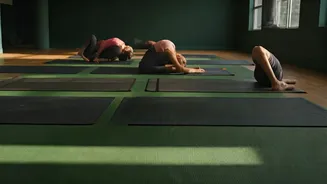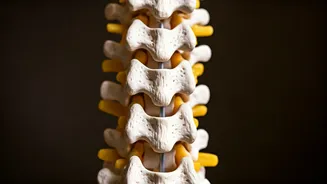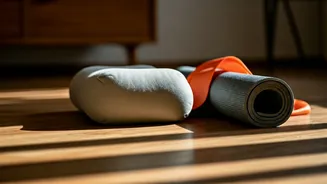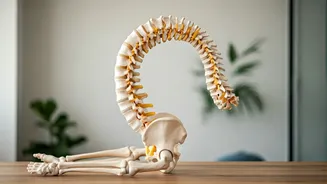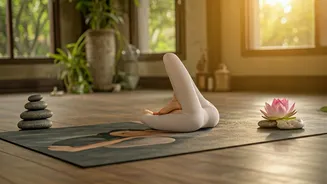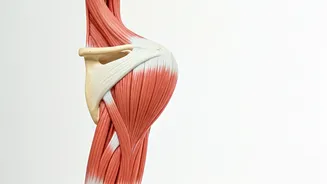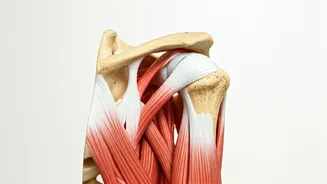Understanding Lower Back
Lower back pain, a common ailment, affects people of all ages. Many factors can contribute to this discomfort, including poor posture, muscle strains,
and underlying conditions. It is important to know that the human spine is a complex structure of bones, muscles, and nerves. Prolonged sitting, heavy lifting, or sudden movements can stress these components, leading to pain. While some cases require medical intervention, many instances of lower back pain can be managed through simple exercises and lifestyle adjustments. Regular stretching is a practical approach to alleviate pain by increasing flexibility, reducing stiffness, and strengthening the muscles that support the spine.
Knee-to-Chest Stretch
The knee-to-chest stretch is a foundational exercise for lower back pain. To perform this stretch, lie on your back with your knees bent and feet flat on the floor. Gently bring one knee towards your chest, holding it with your hands. Ensure that your lower back remains flat on the floor, and hold the stretch for about 30 seconds. Repeat the process with the other leg. Then, you can try both knees at once, bringing them towards the chest and holding for a similar duration. This stretch helps to gently lengthen the lower back muscles, providing relief from tension and reducing pressure on the spinal discs. Doing this stretch carefully and slowly, you can often feel an immediate sense of relaxation in your lower back.
Pelvic Tilts Explained
Pelvic tilts are another simple yet effective exercise for strengthening core muscles and reducing lower back pain. To begin, lie on your back with your knees bent and your feet flat on the floor, similar to the knee-to-chest stretch. Place your hands on your abdomen. Gently tilt your pelvis backward, pressing your lower back into the floor. You should feel your abdominal muscles engaging. Hold this position for a few seconds, and then tilt your pelvis forward, creating a slight arch in your lower back. Repeat this motion several times, focusing on controlled movements. Pelvic tilts enhance core stability, which is vital for supporting the spine and preventing future episodes of back pain.
Cat-Cow Yoga Stretch
The Cat-Cow stretch, taken from yoga, is a great dynamic stretch for improving spinal flexibility. Start on your hands and knees, with your hands directly under your shoulders and your knees under your hips. For the 'cow' pose, drop your belly towards the floor, arch your back, and lift your head and tailbone towards the ceiling. Then, for the 'cat' pose, round your spine toward the ceiling, tuck your chin to your chest, and gently press the floor away with your hands. Alternate between these two poses slowly and smoothly for about a minute. This stretch enhances circulation, reduces spinal stiffness, and increases the range of motion in the spine, contributing to a more comfortable and flexible back.
Piriformis Muscle Stretch
The piriformis muscle, located deep in the buttocks, can often cause lower back and sciatica pain when it becomes tight. To stretch this muscle, lie on your back with your knees bent and your feet flat on the floor. Cross one ankle over the opposite knee. Then, gently pull the thigh of the lower leg towards your chest. You should feel a stretch in the buttock of the leg with the ankle crossed. Hold this position for about 30 seconds and then repeat on the other side. This stretch helps to relieve pressure on the sciatic nerve, reduce pain, and increase flexibility in the hip and lower back region. It is particularly beneficial for those who sit for long periods.
Spinal Twist Stretch
Spinal twists are excellent for improving spinal mobility and relieving lower back stiffness. Lie on your back with your knees bent and feet flat on the floor. Keeping your shoulders flat on the floor, slowly lower your knees to one side. Hold this position for approximately 30 seconds, then return your knees to the center and repeat on the other side. You can increase the stretch by gently reaching your arm in the opposite direction of your knees. This twist helps to gently decompress the spine, increase blood flow, and release tension in the back muscles. This stretch aids in improving spinal flexibility and reducing pain.
Hamstring Stretches Overview
Tight hamstrings often contribute to lower back pain, as they pull on the pelvis and increase stress on the spine. There are several hamstring stretches you can try. One simple stretch is to sit on the floor with your legs straight out in front of you. Reach towards your toes, keeping your back straight. Another option is a standing hamstring stretch, where you place one foot on an elevated surface and lean forward from your hips. Holding each stretch for about 30 seconds will help improve flexibility and ease the tension in your back. The key is to stretch regularly and avoid bouncing, which could cause injury. Consistently stretching your hamstrings will greatly reduce the load on your lower back.
Cobra Pose From Yoga
The cobra pose, also from yoga, is designed to gently stretch the abdominal muscles and strengthen the back. Lie on your stomach with your hands under your shoulders, elbows close to your body. Gently push up, lifting your chest off the floor while keeping your hips on the ground. Hold this position for a few seconds, feeling the stretch in your abdomen and lower back. Be careful not to overextend your back. Repeat this pose a few times, gradually increasing the height of your lift. This pose strengthens the muscles that support your spine and opens up the chest, which is beneficial for posture and reducing lower back pain. Start slowly and listen to your body to avoid injury.
